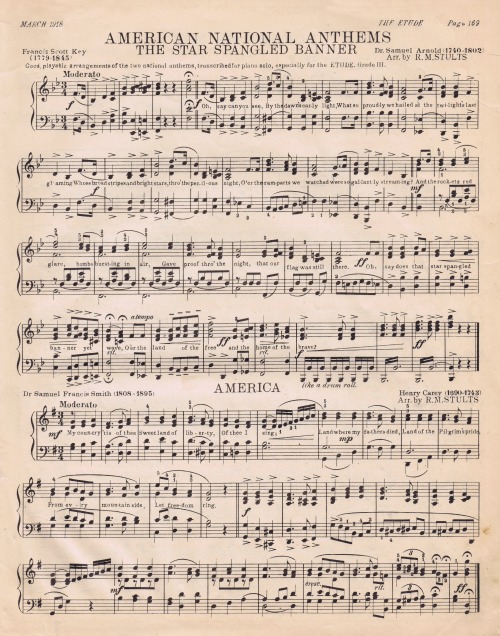
The music for a club tune had become the official song for the world’s most powerful country.The Star Spangled Banner The Star Spangled Bannerĭuring the 1800's, the tunes of popular songs often were used for another set of lyrics.

In 1889, The Star-Spangled Banner was adopted for official use by the US Navy, and in 1916, President Woodrow Wilson ordered that the song be played during official military events.īut it wasn’t until 1931 that The Star-Spangled Banner was made the US national anthem by an Act of Congress. He died in London in 1836.īy the time of the US civil war, the fusion of Smith’s music with Key’s lyrics had arguably become America’s most beloved song. He also built an extensive collection of musical documents and authored musical anthologies. Smith, however cheated he may have felt, served as an organist at the Chapel Royal in London, where he composed music both sacred and secular.

The composer “seems to have scorned public acclaim”, according to William Lichtenwanger, who speculates that Smith had composed the song for a flat fee from the Anacreontic Society, to which he then yielded all rights.įor all the countless times everyone outside the society heard his song, the composer would not be remunerated one bit. And one might wonder how the composer – an Englishman who lived during both the American revolutionary war and the war of 1812 – would have felt about Americans, and eventually the entire United States, using his composition.ĭespite the song’s enormous popularity, Smith apparently made no effort to broadcast his authorship. It is unknown how Smith felt about Key’s lyrics, which commemorated a battle between the US and Britain. Key, a lawyer and amateur poet, had long enjoyed the Anacreontic song, and had used Smith’s composition a decade earlier as the music for a different poem. When Francis Scott Key wrote his Star-Spangled lyrics after witnessing the 1814 Battle of Baltimore, To Anacreon in Heaven still was wildly popular in the US, where “every one who could sing seemed to be singing it”, according to the 1873 edition of The American Historical Record. In that era, a musical piece could be used infinite times in infinite ways. Though the federal Copyright Act of 1790 protected authors of books, maps, and charts, it did not include musical compositions. It’s unknown exactly when the Anacreontic song reached America, but soon enough Smith’s composition became the score for many different songs in the States. Though London’s Anacreontic Society dissolved in the early 1790s, the defunct club’s anthem was reverberating across the UK and eventually across the Atlantic. The Anacreontic song’s date of composition is unknown, but it was probably composed in the early to mid-1770s and soon began appearing in anthologies of printed music. As members belted out the lyrics, they would stand “hand in hand to signify good fellowship”, according to William Lichtenwanger’s The Music of the Star-Spangled Banner: From Ludgate Hill to Capitol Hill. The final two lines of To Anacreon in Heaven – AKA the Anacreontic song – were sung in unison by everyone in attendance. The song’s lyrics were written by fellow Anacreontic Ralph Tomlinson, who served as the society’s president.

Photograph: Rischgitz/Getty ImagesĪlso performed every meeting was the society’s anthem, To Anacreon in Heaven, whose music was composed by Smith. Samuel Johnson was a member of the Anacreontic Society. Following dinner, various songs, puppet shows, and other convivial activities would transpire. At the concert’s conclusion, dinner was served. This venue was needed to hold its increasing membership, which rose from a few dozen to 80, according to the 1780 edition of The Gentleman’s Magazine and Historical Chronicle.Īnacreontic Society events, which occurred every other Wednesday, would begin with a concert featuring London musicians. Though Boyce was old and growing deaf, he nurtured Smith’s growing musical prowess, which saw him accepted into the Anacreontic Society (named after the ancient Greek poet Anacreon, who was known for lyrics about drinking and romance), an elite social club boasting such members as writers Samuel Johnson and James Boswell.įounded in the mid-1760s, the Anacreontic Society first met in various London taverns before relocating to the Crown and Anchor Tavern in the Strand. The son of a cathedral organist, Smith, as a young man, joined the Chapel Royal in London, where he received instruction from the composer William Boyce. The British composer’s identity was a subject of speculation until the 20th-century discovery of a manuscript that identified him as John Stafford Smith, a Gloucester native born in March 1750.


 0 kommentar(er)
0 kommentar(er)
